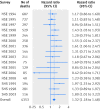Psychological distress in relation to site specific cancer mortality: pooling of unpublished data from 16 prospective cohort studies
- PMID: 28122812
- PMCID: PMC5266623
- DOI: 10.1136/bmj.j108
Psychological distress in relation to site specific cancer mortality: pooling of unpublished data from 16 prospective cohort studies
Abstract
Objective: To examine the role of psychological distress (anxiety and depression) as a potential predictor of site specific cancer mortality.
Design: Pooling of individual participant data from 16 prospective cohort studies initiated 1994-2008.
Setting: Nationally representative samples drawn from the health survey for England (13 studies) and the Scottish health survey (three studies).
Participants: 163 363 men and women aged 16 or older at study induction, who were initially free of a cancer diagnosis, provided self reported psychological distress scores (based on the general health questionnaire, GHQ-12) and consented to health record linkage.
Main outcome measure: Vital status records used to ascertain death from 16 site specific malignancies; the three Scottish studies also had information on cancer registration (incidence).
Results: The studies collectively contributed an average of 9.5 years of mortality surveillance during which there were 16 267 deaths (4353 from cancer). After adjustment for age, sex, education, socioeconomic status, body mass index (BMI), and smoking and alcohol intake, and with reverse causality (by left censoring) and missing data (by imputation) taken into account, relative to people in the least distressed group (GHQ-12 score 0-6), death rates in the most distressed group (score 7-12) were consistently raised for cancer of all sites combined (multivariable adjusted hazard ratio 1.32, 95% confidence interval 1.18 to 1.48) and cancers not related to smoking (1.45, 1.23 to 1.71), as well as carcinoma of the colorectum (1.84, 1.21 to 2.78), prostate (2.42, 1.29 to 4.54), pancreas (2.76, 1.47 to 5.19), oesophagus (2.59, 1.34 to 5.00), and for leukaemia (3.86, 1.42 to 10.5). Stepwise associations across the full range of distress scores were observed for colorectal and prostate cancer.
Conclusion: This study contributes to the growing evidence that psychological distress might have some predictive capacity for selected cancer presentations, in addition to other somatic diseases.
Published by the BMJ Publishing Group Limited. For permission to use (where not already granted under a licence) please go to http://group.bmj.com/group/rights-licensing/permissions.
Conflict of interest statement
All authors have completed the ICMJE uniform disclosure form at www.icmje.org/coi_disclosure.pdf and declare: no support from any organisation for the submitted work; no financial relationships with any organisations that might have an interest in the submitted work in the previous three years; and no other relationships or activities that could appear to have influenced the submitted work.
Figures




Comment in
-
Anxiety and depression may contribute to an increased risk of death in some cancers.Cancer. 2017 Jul 1;123(13):2389. doi: 10.1002/cncr.30812. Cancer. 2017. PMID: 28621904 No abstract available.
-
Häufiger Krebs bei Angst und Depression?MMW Fortschr Med. 2017 Sep;159(15):38. doi: 10.1007/s15006-017-0005-8. MMW Fortschr Med. 2017. PMID: 28900967 German. No abstract available.
References
-
- Mettler CC, Mettler FA. A history of medicine. Philidelphia: Blakiston; 1947.
-
- Kivimäki M, Nyberg ST, Batty GD, et al. IPD-Work Consortium. Job strain as a risk factor for coronary heart disease: a collaborative meta-analysis of individual participant data. Lancet 2012;380:1491-7. 10.1016/S0140-6736(12)60994-5 pmid:22981903. - DOI - PMC - PubMed
-
- Batty GD, Deary IJ, Zaninotto P. Association of Cognitive Function With Cause-Specific Mortality in Middle and Older Age: Follow-up of Participants in the English Longitudinal Study of Ageing. Am J Epidemiol 2016;183:183-90. 10.1093/aje/kwv139 pmid:26803665. - DOI - PMC - PubMed
-
- Jokela M, Pulkki-Råback L, Elovainio M, Kivimäki M. Personality traits as risk factors for stroke and coronary heart disease mortality: pooled analysis of three cohort studies. J Behav Med 2014;37:881-9. 10.1007/s10865-013-9548-z pmid:24203126. - DOI - PubMed
-
- Steptoe A, Kivimäki M. Stress and cardiovascular disease. Nat Rev Cardiol 2012;9:360-70. 10.1038/nrcardio.2012.45 pmid:22473079. - DOI - PubMed
Publication types
MeSH terms
Grants and funding
LinkOut - more resources
Full Text Sources
Other Literature Sources
Medical
